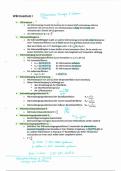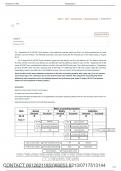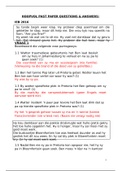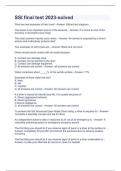Service Operations
Week 1
Lecture
A service is information, solution, emotion, knowledge, transport, activity, and process (e.g.
railway, hairdresser).
Characteristics:
o Certain level/degree of intangibility (compare e.g. restaurant and WhatsApp)
o Customers (1) participate and/or (2) are present in the process
o Simultaneity of consumption and production
o Perishability of the offering
o Heterogeneity of the service offerings due to the variation caused by customers in the
process.
o Labour intensity: different degrees
o Degree of customisation
Service characteristics influence the design of any service delivery system.
Target market: who are the right customers?
A good service system answers the identified needs of a specific target market.
Customer segmentation:
o Based on customer needs and demands
- Needs (e.g. cooking inspiration, time)
- E.g. economising, ethical, personalising, and convenience customers
o Based on demographics
o Based on operational attributes, e.g.
- Required customisation, interaction
- Degree of labour (how much interaction, and personal contact is required to deliver
the service?)
Service concept: what is offered?
Define the benefits a service offers to customers. The service concept captures the nature of
a service so that customers know what they are receiving and employees understand what
they are providing. It’s a shared and articulated understanding of the nature of the service
provided and received.
1
,What:
o Core service: reason of existence
o Facilitating services: facilitate usage of
the core service
o Supporting services: increase value
and/or differentiate
How:
o Interaction: customers’ interaction with
personnel, systems, and other
customers
o Client participation: the role of
customers in the service process and
how clear their role is, e.g. formulate the
right question, use a proper channel for
information
o Accessibility: customers’ access to what
is delivered, which is influenced by
the number of frontline personnel and their skills, office hours, number and difficulty of
forms to fill out
Bundle of benefits for the customer = what is delivered + how the service is delivered
Multi-sided platform is an organisation that creates value primarily by enabling direct
interactions between two (or more) distinct types of affiliated customers (e.g. amazon, Spotify).
Make or buy decisions:
1. If buy: outsource
- Number of suppliers
- Service triads
2. If make: design operations
- Lead time and queues
- Capacity management
Demand types:
2
, Service performance:
o Relevance of measuring service performance
o Difference between relevant subdimensions of service performance (e.g. service quality,
service satisfaction, etc.)
o Know how to identify relevant sub-dimensions of a service performance indicator (e.g. sub-
dimensions of service quality)
o Know how to measure service performance
Week 2
Lecture
Three aims/functions of explicating service system performance:
1. Internal use: to facilitate agreement within an organisation about what is important to
communicate, coordinate, monitor, control and improve.
2. External use: to manage business relationships: to explicate what performance is
expected, agreements, contracts, and partnering.
3. External use: accountability to third parties: to make explicit to others what performance
is/can be expected and is achieved.
Why is explicating service performance complex?
→ Service characteristics:
o Intangibility: how to define performance if what you deliver isn’t touchable or visible?
Service organisation often aim to evoke an emotion, change insights/knowledge, or deliver
an experience. Consequence of intangibility: relationships between what is delivered and
performance indicators isn’t always straightforward.
- Indicators might not measure core service, but turn to measure performance of
supporting and facilitating services, or how the service is delivered (process
indicators).
- Indicators might measure input, assuming that a good input guarantees good output
performance.
o Simultaneous production and consumption: implies that the customer already has
experiences about the performance during the delivery.
Next to outcome performance indicators, this also requires the identification of relevant
process indicators that measure/monitor performance during delivery, such as respectful
contact.
If one wants to influence the performance, this might induce to focus as well on input
indictors to guarantee a certain performance level before the delivery takes place.
o Heterogeneity: the delivery of the same service might vary (due to personnel, time of day,
needs or preferences).
How to interpret and measure performance that requires variety or customisation?
A system might provide a service-mix.
3
Week 1
Lecture
A service is information, solution, emotion, knowledge, transport, activity, and process (e.g.
railway, hairdresser).
Characteristics:
o Certain level/degree of intangibility (compare e.g. restaurant and WhatsApp)
o Customers (1) participate and/or (2) are present in the process
o Simultaneity of consumption and production
o Perishability of the offering
o Heterogeneity of the service offerings due to the variation caused by customers in the
process.
o Labour intensity: different degrees
o Degree of customisation
Service characteristics influence the design of any service delivery system.
Target market: who are the right customers?
A good service system answers the identified needs of a specific target market.
Customer segmentation:
o Based on customer needs and demands
- Needs (e.g. cooking inspiration, time)
- E.g. economising, ethical, personalising, and convenience customers
o Based on demographics
o Based on operational attributes, e.g.
- Required customisation, interaction
- Degree of labour (how much interaction, and personal contact is required to deliver
the service?)
Service concept: what is offered?
Define the benefits a service offers to customers. The service concept captures the nature of
a service so that customers know what they are receiving and employees understand what
they are providing. It’s a shared and articulated understanding of the nature of the service
provided and received.
1
,What:
o Core service: reason of existence
o Facilitating services: facilitate usage of
the core service
o Supporting services: increase value
and/or differentiate
How:
o Interaction: customers’ interaction with
personnel, systems, and other
customers
o Client participation: the role of
customers in the service process and
how clear their role is, e.g. formulate the
right question, use a proper channel for
information
o Accessibility: customers’ access to what
is delivered, which is influenced by
the number of frontline personnel and their skills, office hours, number and difficulty of
forms to fill out
Bundle of benefits for the customer = what is delivered + how the service is delivered
Multi-sided platform is an organisation that creates value primarily by enabling direct
interactions between two (or more) distinct types of affiliated customers (e.g. amazon, Spotify).
Make or buy decisions:
1. If buy: outsource
- Number of suppliers
- Service triads
2. If make: design operations
- Lead time and queues
- Capacity management
Demand types:
2
, Service performance:
o Relevance of measuring service performance
o Difference between relevant subdimensions of service performance (e.g. service quality,
service satisfaction, etc.)
o Know how to identify relevant sub-dimensions of a service performance indicator (e.g. sub-
dimensions of service quality)
o Know how to measure service performance
Week 2
Lecture
Three aims/functions of explicating service system performance:
1. Internal use: to facilitate agreement within an organisation about what is important to
communicate, coordinate, monitor, control and improve.
2. External use: to manage business relationships: to explicate what performance is
expected, agreements, contracts, and partnering.
3. External use: accountability to third parties: to make explicit to others what performance
is/can be expected and is achieved.
Why is explicating service performance complex?
→ Service characteristics:
o Intangibility: how to define performance if what you deliver isn’t touchable or visible?
Service organisation often aim to evoke an emotion, change insights/knowledge, or deliver
an experience. Consequence of intangibility: relationships between what is delivered and
performance indicators isn’t always straightforward.
- Indicators might not measure core service, but turn to measure performance of
supporting and facilitating services, or how the service is delivered (process
indicators).
- Indicators might measure input, assuming that a good input guarantees good output
performance.
o Simultaneous production and consumption: implies that the customer already has
experiences about the performance during the delivery.
Next to outcome performance indicators, this also requires the identification of relevant
process indicators that measure/monitor performance during delivery, such as respectful
contact.
If one wants to influence the performance, this might induce to focus as well on input
indictors to guarantee a certain performance level before the delivery takes place.
o Heterogeneity: the delivery of the same service might vary (due to personnel, time of day,
needs or preferences).
How to interpret and measure performance that requires variety or customisation?
A system might provide a service-mix.
3










